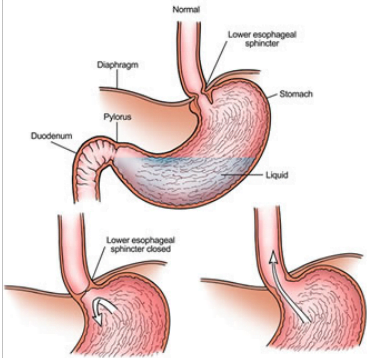Staging tests can show the stage (extent) of esophageal cancer, such as whether cancer cells have spread to other parts of the body.
When cancer of the esophagus spreads, cancer cells are often found in nearby lymph nodes. Esophageal cancer cells can spread from the esophagus to almost any other part of the body, such as the liver, lungs, or bones.
Staging tests may include...
- CT scan: Your doctor may order a CT scan of your chest and abdomen. An x-ray machine linked to a computer will take a series of detailed pictures of these areas. You'll receive contrast material by mouth and by injection into a blood vessel in your arm or hand. The contrast material makes abnormal areas easier to see. The pictures can show cancer that has spread to the liver, lungs, bones, or other organs.
- PET scan: Your doctor may use a PET scan to find cancer that has spread. You'll receive an injection of a small amount of radioactive sugar. A machine makes computerized pictures of the sugar being used by cells in the body. Because cancer cells use sugar faster than normal cells, areas with cancer cells look brighter on the pictures. The pictures can show cancer that has spread to the lymph nodes, liver, or other organs.
- EUS:Â An EUS (endoscopic ultrasound) can show how deeply the cancer has invaded the wall of the esophagus. It can also show whether cancer may have spread to nearby lymph nodes. Your doctor will pass a thin, lighted tube (endoscope) through your mouth to your esophagus. A probe at the end of the tube sends out high-energy sound waves. The waves bounce off tissues in your esophagus and nearby organs, and a computer creates a picture from the echoes. During the exam, the doctor may take tissue samples of lymph nodes.
Stages
Doctors describe the stages of esophageal cancer using the Roman numerals I, II, III, and IV. Stage I isearly-stage cancer, and Stage IV is advanced cancer that has spread to other parts of the body, such as the liver.
The stage of cancer of the esophagus depends mainly on...
- How deeply the tumor has invaded the wall of the esophagus
- The tumor's location (upper, middle, or lower esophagus)
- Whether esophageal cancer cells have spread to lymph nodes or other parts of the body
Stages I and II of Adenocarcinoma of the Esophagus
Stage IA
Cancer has grown through the inner layer and invades the wall of the esophagus. The grade is 1 or 2.
Stage IB
Cancer has invaded the wall of the esophagus and is grade 3. Or, cancer has invaded more deeply into the muscle layer of the esophagus, and the grade is 1 or 2.
Stage IIA
Cancer has invaded the muscle layer of the esophagus, and the grade is 3.
Stage IIB
Cancer has invaded the outer layer of the esophagus. Or, cancer has not invaded the outer layer, but cancer cells are also found in one or two nearby lymph nodes.
Stages I and II of Squamous Cell Cancer of the Esophagus
Stage IA
Cancer has grown through the inner layer and invaded the wall of the esophagus. The grade is 1.
Stage IB
Cancer has invaded the wall of the esophagus and is grade 2 or 3. Or, cancer is found in the lower part of the esophagus, it has invaded the muscle layer or outer layer of the esophagus, and the grade is 1.
Stage IIA
Cancer is found in the upper or middle part of the esophagus, it has invaded the muscle layer or outer layer of the esophagus, and the grade is 1. Or, cancer is found in the lower part of the esophagus, it has invaded the muscle layer or outer layer of the esophagus, and the grade is 2 or 3.
Stage IIB
Cancer is found in the upper or middle part of the esophagus, it has invaded the muscle layer or outer layer of the esophagus, and the grade is 2 or 3. Or, cancer has not invaded the outer layer, and cancer cells are found in one or two nearby lymph nodes.
Stages III and IV of Esophageal Cancer (Both Types)
Stage IIIA
Stage IIIA is one of the following:
- Cancer has not invaded the outer layer, and cancer cells are found in 3 to 6 nearby lymph nodes.
- Or, cancer has invaded the outer layer of the esophagus, and cancer cells are also found in 1 or 2 nearby lymph nodes.
- Or, cancer extends through the esophageal wall and has invaded nearby tissues, such as thediaphragm or pleura. No cancer cells are found in lymph nodes.
Stage IIIB
Cancer has invaded the outer layer of the esophagus, and cancer cells are found in 3 to 6 nearby lymph nodes.
Stage IIIC
Stage IIIC is one of the following:
- Cancer has invaded tissues near the esophagus, and cancer cells are found in up to 6 nearby lymph nodes.
- Or, cancer cells are found in 7 or more nearby lymph nodes.
- Or, the cancer can't be removed by surgery because the tumor has invaded the trachea or other nearby tissues.
Stage IV
The esophageal cancer has spread to other parts of the body, such as the liver, lungs, or bones.






